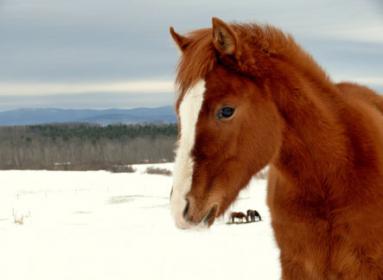[QUOTE=melhorse;7242121]
Here is some information on winter blanketing that may surprise you-
This is the result of a multi-year study done by CSU, using state of
the art thermal detection equipment. Colorado State University is
widely considered to be one of the top three equine veterinary
schools in the country: Blanketing horses is one of the worst things
that you can do to a horse in the winter. Horses have the ability to
loft and lower their coats to 17 different levels, so it’s like
exchanging 17 different thermal weights of blankets off and on them
all day and night, depending on what they need- except that we don’t
know what they need as well as they do. Their ‘self-blanketing’
process works a little like ‘chill bumps’ do in our own skin. That’s
why long-haired horses may seem fluffier on some days than on others.
Only three things make the ‘self-blanketing’ process not work:
blanketing, clipping, and wind. Not even snow or rain stops their own
thermostats from doing the job. Also horses are in ‘neutral’ (meaning
not using energy for either heating or cooling) when the air around
them is between 26 and 38 degrees. Otherwise, they’re using energy to
control their temps. So- since they’re cooling their bodies when the
temp is over 38 degrees, they’re having to use extra energy to cool
themselves when blanketed in temperatures over that. Any time a horse
that is outside and has a long coat is shivering, it’s because the
horse has opted to shiver to warm itself, instead of using the option
of moving. Moving generates a considerable amount of heat for a
horse, but they sometimes stand and shiver while napping, etc. It
does not mean that they need to be blanketed. However- a horse MUST
have a way to get out of the wind in order for their
‘self-blanketing’ abilities to function fully.
It turns out that blanketing is done more for pleasing the human, than to fill a needof the horse. The horse blanket industry has done a great job of
making us think that their product is a necessary part of good
horse keeping- when it is actually an item that is very seldom needed.[/QUOTE]
No no no no, just…no :no: :no:
Not only is there so much wrong with that, it’s not even the result of a study, much less any study that CSU did.
It’s total garbage.
I did not blanket my weanling. I did not want to buy a blanket his size, even used - I tend to hang on to everything and I wouldn’t need it again for at least 10 years LOL
I brought them in for the nasty weather, which really means prolonged cold rain, or driving sleet. Cold was never a problem. I’d bring in anyway for driving sleet - that stuff just hurts.
rodawn made the best point - time of year vs weather conditions. Jan and a 40* rain is very different from late Oct or early March and 40* rain, because of the condition of the coats.
Just do what seems best for that particular horse. Nothing wrong with stalling the baby for the worst weather if you think he’s not equipped to deal well with it in your situation.
 and their body temps are higher, so not so blanket them unless it’s “really cold” true or false?
and their body temps are higher, so not so blanket them unless it’s “really cold” true or false?

 No blankies here
No blankies here